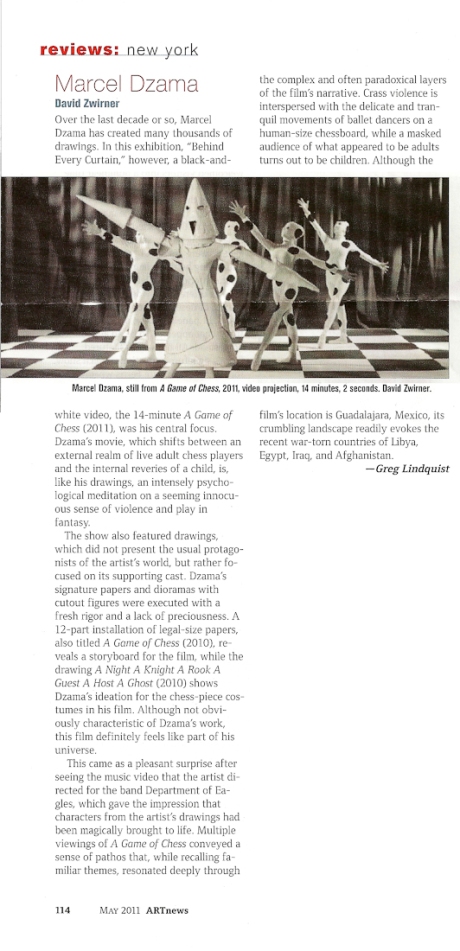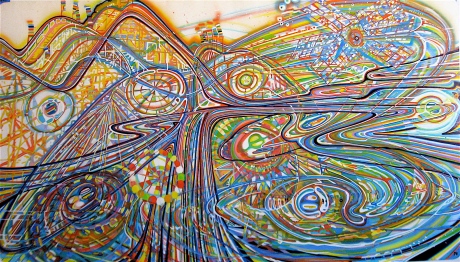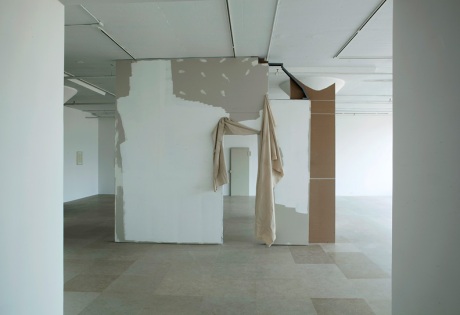NEW YORK STUDIO SCHOOL
JUNE 3 – AUGUST 7, 2010
Reposted from Brooklynrail.org

Tape and steel are the constituent materials of Rebecca Smith’s sculptural practice, and now they are the subject of her exhibition at the New York Studio School. Almost as if to emphasize this fact, Smith has titled her exhibition after these materials with an ironically complex machismo ring that evokes the Modernist sculpture of her father, David Smith. This exhibition strives to interlay the two previously segregated yet related material concerns, but best elucidates Smith’s painting-sculpture hybrids, which are punctuated by linear elements created by various types of tape. Preciously arranged, genteelly self-contained, beautifully crafted, these sculptures function, like paintings, as discrete objects. Even installed at wall scale, they sit on the architecture rather than becoming part of it.
In the exhibition catalog Smith states, “The grid is certainly the way the human-made world is set up, yet we deviate from it all the time. I had thought that the last thing I would ever want to work with was the grid, because it seems so tired out as a concept.”
Smith’s visual structure extends the legacy of Modernism yet also perverts, by degrees, the order in, say, Mondrian’s grid paintings. The sculptures’s titles often refer to the natural world—the glacial ice shelf, insects, plants, and animals—yet their materiality points to their components’ utilitarian applications: urban window guards, automobile interference paints, fire escapes.
Tape in Smith’s studio functions as a sketching tool for visualizing forms that will be fabricated in steel. Tape has also been the poetic, calligraphic, and elegant gestural subject of several of Smith’s more exploratory installations. In these works, it has been treated without economy or boundary, playfully engaging and layering the entire architectural space. However, in this exhibition, tape feels circumscribed as a connector of liminal space between, as well as, in the service of the sculptures, becoming a literal gesture of connection rather than an aesthetic encompassment.
In dialogue, with the various directions and impulses over Smith’s career, combining these materials feels like a necessary step. I sense a restrained Post-minimalist theatrical sensibility at play: in the catalog interview, Smith discusses stacking or interlocking several floor pieces in the rear gallery; this idea, however, is unrealized, which is a disappointment. I wonder how a denser installation might have engaged the viewer, both visually and physically, as well as complicate the works’ individual objectness. I also wonder how it might have invited more interaction and interconnectedness among the exhibition’s individual pieces. There are glimpses in some interstices, such as the white tape running under “Green Insect” (2009) and rippling into a ribbon-like form, and I am curious to see these materials more exaggeratedly placed, layered, and ordered (or disordered, as her sculptures demand of the Modernist grid). Perhaps, then, the experience will further transcend its intrinsic materiality of tape and steel.
October 15- November 15, 2010
177 N 9th Street, between Bedford and Driggs avenues
Brooklyn, 718 599 2144
 Ati Maier, Disappeared Time”, 2010. Airbrush, ink, woodstain on paper, 24 x 10 1/2 inches. Courtesy of Pierogi Gallery.
Ati Maier, Disappeared Time”, 2010. Airbrush, ink, woodstain on paper, 24 x 10 1/2 inches. Courtesy of Pierogi Gallery.
You might have the momentary impression that Daniel Zweller and Ati Maier’s concurrent solo exhibitions, composed mostly of mid-sized works on paper, are quintessential Pierogi shows. It is no secret that many of the gallery’s artists adhere to a brand of obsessive, often intricately restrained, markmaking akin to that “Brooklyn aesthetic” once dubbed by David Cohen as “School of fuss and fiddle.” While Zweller’s show broods over a fanatical, labyrinthine precision, however, Maier’s paintings and drawings (both formats originate on paper but to different scales and densities) express meandering, pulsing meditations on the terrestrial and planetary, virtual and physical. While the paper works take a central axis, they orbit in a constellation of a wall installation and video animations.
Based in processes of chance and discovery, Maier works successive layers of airbrush, ink and wood stain into contracting and expanding spacescapes that accumulate scientific theory, satellite imagery, graphic advertising sensibilities and geological models. Visualizing these often virtually perceived territories, Maier’s imagined spaces recall the internet ether paintings of Benjamin Edwards or the wry architectural palimpsests of Julie Mehretu’s “Gray Area” paintings as recently seen at the Guggenheim.
While retaining an equally terrestrial and otherworldly character, Maier’s most recent work is denser than previous and more varied in its markmaking. The imagery is increasingly abstracted and acquiescent to less identifiable and circuitous patterning. Works such as Disappeared Time and The Great Dipper (both 2010) are interplanetary roller coasters for the eyes and the mind, as unclassified otherworldly visuals coalesce and collide with recognized sources.
Hovering clusters of laptop/turntable-sized framed works hang on the gallery’s longest wall. Painted in an enveloping black rectangle with rounded corners, the wall echoes the work’s paper edges and suggests an allover imbrecation of worlds. There are various compositions of orbs within one another and others that are consolidated as a single aesthetic pictorial observatory. The rounded rectangular shapes have an ergonomic sleekness and design, recalling Maier’s 2003 plexiglass capsule frames and, although it may be a stretch, the lozenges of candy raver/DJ pill culture.
Nearly buried in this installation on an office wall near Maier’s exhibition are Maier’s video pieces “Space Rider” and “Event Horizon” (2009 and 2010 respectively). Subverting the white cube and occupying an ambiguous temporal space, “Event Horizon” was installed earlier this fall atop the ceiling of a grand staircase in a disused philharmonic building in the Lodz Biennial in Poland. A synthetic skylight, digital
planetarium, or android/dendroid-like organism, this video installation visualizes what one might imagine of her painting’s construction: a circular raveling and unraveling of lines from the center to edges, the endless accumulation of data and aesthetic happenstance. The pulsing of this digital creature is the interweaving and interlaying of three warped and transposed landscapes. Inspired by science and the eleven stringed dimensions of reality in the M theory, Maier brings her work contextually and conceptually into new realms.
Between the cluster of works on paper and of video animations, Maier’s work loiters on the fringes of an all-immersive installation. I can easily imagine double-sided drawings of various scales encapsulated in rounded plexiglass rectangles, suspended from the ceiling at different heights and angles. A video such as “Event Horizon” could occupy a concaved ceiling, as she originally intended for this animation. This isn’t intended to be prescriptive; it’s simply clear that as Maier moves back and forth from three-dimensional to illusionistic space more freely, additional aesthetic, conceptual and contextual possibilities will continue to emerge.
Ati Maier, The Giant Dipper, 2010. Airbrush, ink woodstain on paper, 94-1/2 x 53 inches. Courtesy of Pierogi Gallery.
Installation shot of exhibition under review, Ati Maier: The Great Dipper, Pierogi 2000, Williamsburg, 2010
Reposted from Brooklynrail.org
GREENE NAFTALI GALLERY | OCTOBER 22 – DECEMBER 4, 2010
“The Cutters, From The Center, Her Trumpeted Spoke Lastly,” 2007 / 2010. Canvas, paint, wall, hollow-core door, matted drawing reversed in frame. 137 × 164 × 13 inches. 348 × 416.6 × 33 cm. Courtesy Greene Naftali Gallery, New York
Since the railroad-style building next door to my apartment is adjacent to a parking lot, I can see its entire inside wall as a façade rather than a continuous row of houses. This bleached yellow vinyl siding is attached in foot-wide, horizontal striations that span the entire length of the building. This pattern has a satisfying order, in a Modernist ethos. It lends a sense of stalwart permanence to the otherwise flimsy structure. In the past couple months, though, a wind storm has dislodged two adjoining strips of a car’s length, causing the wobbly material to flop away from the building in a loopy arch along the lot’s sidewalk.
At first I felt compelled to return the siding to its original position. Its refusal to behave as intended, though, has become surprising and provocative. As I’ve stared from my desk window into the parking lot, I have fixated on this proposition of urban neglect. It occurred to me: Gedi Sibony would love this wonky, displaced vinyl siding. I can imagine Sibony, who is a known hoarder of things, lovingly ferrying the vinyl segments to his studio. In an exhibition, he might install them in an eloquent gesture recalling a Robert Morris felt piece—draped from the wall, cascading to the floor.
This fantasy of aesthetic possibility raises central questions of context, process, and intention in Sibony’s work. Does the sculpture require a white cube in order to be meaningfully experienced? Is his work simply one of selection or does an actual transformation occur in his contextual displacement? Irreverence toward a material’s original function (and context), preciousness in its preservation, and fetishization of its form (divorced from its original function) are central to Sibony’s sensibility, and apparent in his current exhibition at Greene Naftali Gallery.
Sibony’s deeply mediated presentation determines that the amount of space surrounding a rickety, two-by-four-lumber-based structure in “Asleep Outside The Wall” (2010) (suggesting a Trojan horse from one view and an oversimplified, third-world slum shanty from another) constitutes aesthetic or semantic clout, suggesting that the less information he gives, the more meaning he creates. Also, by hanging a reversed carpet on the wall, as in “The Center, and Skinny Legs, Satisfying The Purposes Completely, Her Trumpeted Spoke Lastly” (2010), Sibony disrupts the way we read cues of conventional display—that paintings hang on the wall, while rugs go on the floor. He also drapes irregular, unstretched shapes of raw canvas from the gallery corner in “Who Attracts All That is Named” (2010).
Post-Dave Hickey’s The Invisible Dragon essays, I am extremely reluctant to use the word beauty in discussing Sibony’s sculptures. I don’t think Sibony intends to engage in any overt politics, at least as Hickey explains politics. Nonetheless, this show has challenged my expectations of what level of material transformation constitutes aesthetic experience. If Yves Klein pursued the immaterial through an audacious dematerialization of the art object, then Sibony is striving for something somewhere in between what is aestheticized and what is poised to appear aestheticized by cues external to the art object, such as theatricality, placement, and appearance. Also, the real time experience of a body in space is important in Sibony’s work, leaving the photographic documentation of the exhibition alluring, yet ultimately hollow.
I’m not sure if the resulting effect is poetic. Sometimes Sibony’s work feels transformed beyond its material means, such as in the James Turrell-esque room of light; sometimes a sofa with a cut-out deer silhouette and scattered sheets is just that. Except in a gallery. And the sofa is hovering above the floor. As a matter of fact, the titles’ obtuse and obscuring sensibilities seem anti-poetical in their refusal, like the sculptures themselves, to tell you anything beyond indeterminate impressions. Or is that a certain brand of poetics? Sibony’s titles sometimes appear to be a product of a Dadaist assemblage and other times verge on a saccharine sort of sentimentality, as in “The Brighter Grows the Lantern.”
Sibony’s care with words also applies to his craft. Meant to appear roughly cut, jagged and haphazard, the construction of “The Cutters” (2007–2010) is as intentional and meticulous as the draped-canvas framing of the hollow-core door on the rear wall. (Sibony is particularly adept at composing views with architectural elements in space.) To say this piece of craggy, unfinished wall was a send-up of Gordon Matta-Clark would be missing a distinction in their varying engagements of process. Urs Fischer’s 2006 Whitney Biennial interior alterations behaved in a way similar to Sibony’s architecture constructions. In Sibony and Fischer, their aesthetic ends defeat their means, unlike Matta-Clark’s engagement in urban, socio-economic issues.
Although his work has been tirelessly compared to the Arte Povera movement, environmental concerns and politics are noticeably absent here (even if Sibony is said to be anti-institutional in his shoddy touch). Discussing Sibony with regard to Postminimalism accounts for neither his pathos of degeneration in terms of material identity and function, nor his pseudo-preservationalist stance vis-à-vis what is sometimes plainly garbage. Robert Rauschenberg’s cardboard box pieces, currently on view at Gagosian, are striking precedents for Sibony’s transformation of materials, though Rauschenberg aestheticized these boxes comparatively little, even while they both translate materials with precious, miniscule steps, or none at all. Rauschenberg’s cardboard sculptures are more generous, less homogenizing, and display material curiosity rather than withholding it.
All of this said, my thoughts ultimately return to the readymade Sibony in the outside world. What does it say if something can resemble a Gedi Sibony? For all his strategies for not making a “Gedi Sibony,” does this suggest he has in fact packaged his moves for this exhibition? I’m not sure it really matters: after all, it’s not a Gedi Sibony sculpture until it’s placed in a gallery. This is the world in which his work challenges our visual endurance and tolerance for what constitutes meaningful aesthetic experience.









